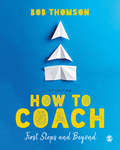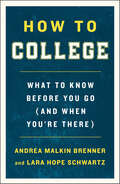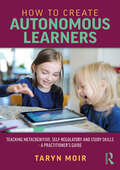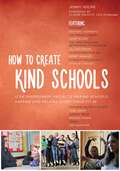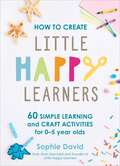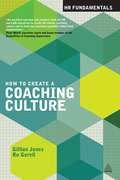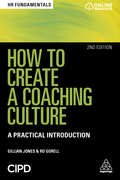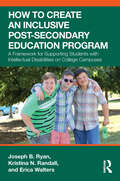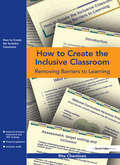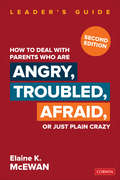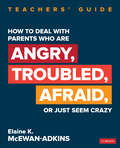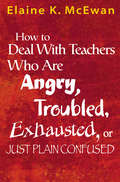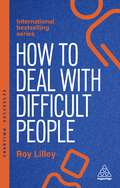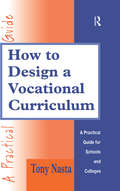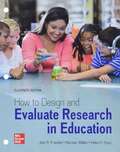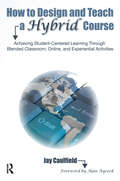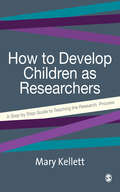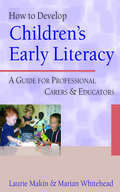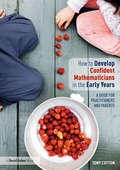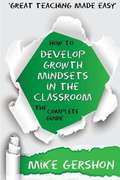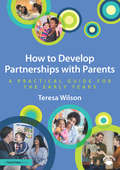- Table View
- List View
How to Coach: First Steps and Beyond
by Bob ThomsonHow to Coach: First Steps and Beyond is an essential guide for anyone starting out in the coaching profession and for existing coaches seeking to develop their craft. It is a practical introduction to the theory, skills and art of coaching. This extremely practical introduction contains numerous case studies showing theory in action, aiding in understanding of how to apply theory to actual practice in a variety of settings. The book: Uses clear, uncomplicated language throughout Explains key ideas through brief illustrations from the author′s practice and quotes from leading writers on coaching Contains a wide selection of ideas, models and exercises to stimulate the reader′s learning Encourages students to try things out in conversation, and reflect upon and make sense of their experiences How to Coach is a must-have book for anyone interested in coaching skillfully, ethically and effectively.
How to Coach: First Steps and Beyond
by Bob ThomsonHow to Coach: First Steps and Beyond is an essential guide for anyone starting out in the coaching profession and for existing coaches seeking to develop their craft. It is a practical introduction to the theory, skills and art of coaching. This extremely practical introduction contains numerous case studies showing theory in action, aiding in understanding of how to apply theory to actual practice in a variety of settings. The book: Uses clear, uncomplicated language throughout Explains key ideas through brief illustrations from the author′s practice and quotes from leading writers on coaching Contains a wide selection of ideas, models and exercises to stimulate the reader′s learning Encourages students to try things out in conversation, and reflect upon and make sense of their experiences How to Coach is a must-have book for anyone interested in coaching skillfully, ethically and effectively.
How to College: What to Know Before You Go (and When You're There)
by Andrea Malkin Brenner Lara Hope SchwartzThe first practical guide of its kind that helps students transition smoothly from high school to collegeThe transition from high school—and home—to college can be stressful. Students and parents often arrive on campus unprepared for what college is really like. Academic standards and expectations are different from high school; families aren’t present to serve as “scaffolding” for students; and first-years have to do what they call “adulting.” Nothing in the college admissions process prepares students for these new realities.As a result, first-year college students report higher stress, more mental health issues, and lower completion rates than in the past. In fact, up to one third of first-year college students will not return for their second year—and colleges are reporting an increase in underprepared first-year students.How to College is here to help. Professors Andrea Malkin Brenner and Lara Schwartz guide first-year students and their families through the transition process, during the summer after high school graduation and throughout the school year, preparing students to succeed and thrive as they transition and adapt to college. The book draws on the authors’ experience teaching, writing curricula, and designing programs for thousands of first-year college students over decades.
How to Create Autonomous Learners: Teaching Metacognitive, Self-regulatory and Study Skills – a Practitioner’s Guide
by Taryn MoirTo achieve their full potential, it is essential that children develop skills to become autonomous learners, yet this skill does not come naturally to many learners. This book is a practical teaching and planning guide to the theory, practice and the implementation of evidence-based approaches to develop essential metacognitive and self-study skills. How to Create Autonomous Learners explains how to get students, parents and partners on board and how to implement these ideas across a class, school, or consortium. Areas covered include: • How to get children and young people ready to learn. • Why it is important to teach learning strategies. • Encouraging children to become more active in the process of learning while also nurturing the development of creativity. • How to harness learner motivation as metacognition and motivation are highly linked. Easily applicable in any classroom, this essential resource supports children’s development of important metacognitive, self-regulatory and self-study skills, and provides teachers and school leaders with evidence-based approaches for implementing these ideas with the support of parents, students and partners.
How to Create Kind Schools: 12 extraordinary projects making schools happier and helping every child fit in
by Henry Winkler Anthony Horowitz Friends Michael Sheen Jamie Oliver Families The Prince's Trust Jack Jacobs Charlie Condou Diversity Role Models Nocturn Dance Achievement For All Youth Dance England Baroness Janet Whitaker Jenny Hulme Linda Jasper David Martin Domoney Jane Asher 2faced Dance Beat Kidscape Claude Knights The National Autistic Society Ade Adepitan Kidscape Dance United Carers Trust Nspcc David Charles Manners Thrive Jill Halfpenny The Mentoring Befriending Foundation TravellersCelebrating the 30th Anniversary of Kidscape, the national charity that works to challenge and prevent bullying, this book offers readers an insight into a collection of innovative projects currently running in schools to promote inclusion, tolerance and kindness.<P><P> From a gay role model to a peer mentor, a dance workshop to a gardening club, an autism ambassador to a travelling Gypsy theatre group, the ideas demonstrate how much we have to teach our children about inclusion, how much kindness matters, and how much of a difference schools can make to children who don't always feel they fit. Joining forces with well-known charities and celebrity supporters including Anthony Horowitz, Jamie Oliver, Michael Sheen and more, these accessible, fun and effective projects are tackling issues such as bullying, homophobia, racism, and truancy, are supporting pupils who may feel isolated and excluded from their peer group, and are helping whole schools become happier, more successful settings.<P> This book will provide inspiration to all educational professionals, parents and volunteers looking for creative and practical ways to help individual children fit in and feel happy in their class.
How to Create Little Happy Learners: 60 simple learning and craft activities for 0-5 year olds
by Sophie DavidHow to Create Little Happy Learners presents an inspiring selection of learning and craft activities designed to promote a love of learning. Written by Sophie David, a former early years teacher and adviser who is now a stay-at-home mum with 3 children under 5, she is now channelling her knowledge and creativity to show-case the craft ideas she was using to keep her children entertained. Here, she offers over 60 fun-packed activities for children, all highlighting different skills (fine motor, phonics, maths, creativity, communication and independence). Split into topics ranging from animals to transport, Sophie not only offers crafting activities that involve children and can be used time and time again utilising everyday items, she also adapts each activity for different age groups (from 0-5 years) so you can reuse the book as your child grows.Some activities include:- Searching for animal fossils (phonics and creativity)- Bug Count (problem solving and maths)- Emotion stones (communication)- Creating sensory bags (baby play and motor skills)This book offers a bank of great activities to not only inspire a love of learning in your children but to make that journey a fun, craft filled one.
How to Create Little Happy Learners: 60 simple learning and craft activities for 0-5 year olds
by Sophie DavidHow to Create Little Happy Learners presents an inspiring selection of learning and craft activities designed to promote a love of learning. Written by Sophie David, a former early years teacher and adviser who is now a stay-at-home mum with 3 children under 5, she is now channelling her knowledge and creativity to show-case the craft ideas she was using to keep her children entertained. Here, she offers over 60 fun-packed activities for children, all highlighting different skills (fine motor, phonics, maths, creativity, communication and independence). Split into topics ranging from animals to transport, Sophie not only offers crafting activities that involve children and can be used time and time again utilising everyday items, she also adapts each activity for different age groups (from 0-5 years) so you can reuse the book as your child grows.Some activities include:- Searching for animal fossils (phonics and creativity)- Bug Count (problem solving and maths)- Emotion stones (communication)- Creating sensory bags (baby play and motor skills)This book offers a bank of great activities to not only inspire a love of learning in your children but to make that journey a fun, craft filled one.
How to Create a Coaching Culture
by Ro Gorell Gillian JonesHow to Create a Coaching Culture is a practical guide to developing an effective, efficient coaching culture in your organization. It demonstrates how to empower your workforce to achieve higher performance and greater business results. Specifically tailored to practitioner needs it offers an overview of coaching practice and aligns it clearly with organizational and HR strategy and objectives. Using a combination of practical tools, assessments, scenarios and case studies from best practice it will build your fundamental knowledge and equip you to take action by planning, pitching, and building a scheme. It also offers a complete framework for evaluating benefits and measuring return on investment.
How to Create a Coaching Culture: A Practical Introduction (HR Fundamentals #3)
by Ro Gorell Gillian JonesManagement approaches and workplace culture help determine employee productivity, morale, talent acquisition and retention, and organizational adaptability. How to Create a Coaching Culture is a practical guide to embedding effective coaching behaviours within an organization to empower and engage employees to perform at their best. Using a combination of practical tools, assessments, case studies and examples, it provides guidance on how to plan and develop a strategy aligned to your organization and its goals, engage the board to secure 'buy-in', and how to effectively measure and evaluate initiatives in every stage of the employee lifecycle.This fully updated second edition of How to Create a Coaching Culture contains new material on promoting employee engagement, reinventing performance reviews, and new and updated case studies from HarperCollins, British Airways and Leanintuit. Online resources include a series of downloadable templates and tools to use in practice, including a board report, communication strategy, development plan, and pre- and post-course training assessment.HR Fundamentals is a series of succinct, practical guides for students and those in the early stages of their HR careers. They are endorsed by the Chartered Institute of Personnel and Development (CIPD), the UK professional body for HR and people development, which has over 145,000 members worldwide.
How to Create an Inclusive Post-Secondary Education Program: A Framework for Supporting Students with Intellectual Disabilities on College Campuses
by Joseph B. Ryan Kristina N. Randall Erica WaltersThis essential guide offers a practical framework for developing a successful Post-Secondary Education (PSE) program for students with intellectual disabilities—one of the fastest-growing areas in higher education. Written by leaders of one of the nation's top PSE programs, this book distills their extensive experience mentoring over 90 colleges and universities into a practical, jargon-free guide. Featuring clear, actionable insights for creating a successful, tailor-made program, chapter topics include functional academics, independent living skills, and employment readiness. Written for college administrators, special education teachers, and parents, this book sheds light on how PSE programs not only enrich the college experience for students with intellectual disabilities but also equip them with the skills to thrive as self-sufficient adults.
How to Create the Inclusive Classroom: Removing Barriers to Learning
by Rita CheminaisHot on the heels of the Government's new SEN strategy, this book's at-a- glance' format provides practitioners with a handy self-help resource. This book will help you to: create a learner-friendly barrier-free classroom using checklists to monitor inclusive practice understanding the impact on classroom practice of recent legislation following power point slides detailing government standards and guidance clarify the roles and expectations of pupils, parents, SENCOs, INCOs, teachers and school leaders
How to Deal With Parents Who Are Angry, Troubled, Afraid, or Just Plain Crazy
by Elaine K. McEwan-AdkinsHow do you deal with high-maintenance parents who never seem happy with the job you are doing? Emotionally charged, often disgruntled, and occasionally abusive parents—sound familiar? The second edition of McEwan's best-selling classic will help you manage your most difficult audience, adding several features and examples that will give you the confidence and skills you need to handle such situations, including: Over two dozen strategies—enhanced and updated—to defuse emotionally charged parents An updated, easy-to-administer healthy school checklist Fifty ways to build parental support for your school Ten goals-at-a-glance to help keep your school-community relations on target A built-in facilitator's guide
How to Deal With Parents Who Are Angry, Troubled, Afraid, or Just Seem Crazy: Teachers′ Guide (Corwin Teaching Essentials)
by Elaine K. McEwan-AdkinsStrategies for working with parents of all kinds Parents can be a teacher’s greatest advocate—and that’s why it’s important to know how to handle even the hardest parent situations. In fact, new teachers reported that parent communication is one of their biggest challenges. This teachers’ edition of the all-time best-selling How to Deal With Parents Who Are Angry, Troubled, Afraid, or Just Seem Crazy provides invaluable strategies that teachers can use to defuse angry parents and to work with all parents to advance the success of their children. Addressing a variety of educator needs and concerns, this resource • Helps teachers get parents on their side with a set of proactive practices and policies • Provides guidelines for teachers to follow when meeting with parents during annual reviews and IEP meetings • Includes advice and vignettes that reflect challenges and concerns of today’s teachers With resources that will remain relevant to teachers throughout their careers, this book provides a clear explanation of the complexities that interact to create dysfunctional parents and how teachers can most effectively problem solve, communicate, and learn from their relationships with parents.
How to Deal With Parents Who Are Angry, Troubled, Afraid, or Just Seem Crazy: Teachers′ Guide (Corwin Teaching Essentials)
by Elaine K. McEwan-AdkinsStrategies for working with parents of all kinds Parents can be a teacher’s greatest advocate—and that’s why it’s important to know how to handle even the hardest parent situations. In fact, new teachers reported that parent communication is one of their biggest challenges. This teachers’ edition of the all-time best-selling How to Deal With Parents Who Are Angry, Troubled, Afraid, or Just Seem Crazy provides invaluable strategies that teachers can use to defuse angry parents and to work with all parents to advance the success of their children. Addressing a variety of educator needs and concerns, this resource • Helps teachers get parents on their side with a set of proactive practices and policies • Provides guidelines for teachers to follow when meeting with parents during annual reviews and IEP meetings • Includes advice and vignettes that reflect challenges and concerns of today’s teachers With resources that will remain relevant to teachers throughout their careers, this book provides a clear explanation of the complexities that interact to create dysfunctional parents and how teachers can most effectively problem solve, communicate, and learn from their relationships with parents.
How to Deal With Teachers Who Are Angry, Troubled, Exhausted, or Just Plain Confused
by Elaine K. McEwan-AdkinsUse "Assertive Intervention" techniques to help difficult teachers become positive and energetic professionals! Managing difficult teachers effectively may be a principal’s most pressing challenge. In this research-based text, you will discover approaches that prove how even the most difficult teachers can become successful professionals. This indispensable handbook introduces Assertive Intervention techniques and shows principals how to improve daily interactions with troubled teachers. These strategies show how to: Confront difficult teachers calmly and confidently Conduct an Assertive Intervention Improve interactions with troublesome teachers Build a positive school culture
How to Deal with Difficult People: Fast, Effective Strategies for Handling Problem People (Creating Success)
by Roy LilleyLearn how to navigate the bullies, manipulators and complainers who drive you mad. With example dialogue and techniques, it will help you navigate tricky situations and keep your cool.By understanding the motives and individual behaviours of difficult people, you can learn to manage aggression, reduce awkwardness and remain the better person. This 6th edition of the bestselling Dealing with Difficult People features practical exercises, useful templates and top tips you need to get the best out of the worst, including how to deal with difficult customers, dealing with difficult people in the digital sphere, advice on beating bullies at their own game and how to deal with a boss who drives you barmy.The Creating Success series of books...Unlock vital skills, power up your performance and get ahead with the bestselling Creating Success series. Written by experts for new and aspiring managers and leaders, this million-selling collection of accessible and empowering guides will get you up to speed in no time. Packed with clever thinking, smart advice and the kind of winning techniques that really get results, you'll make fast progress, quickly reach your goals and create lasting success in your career.
How to Design a Vocational Curriculum: A Practical Guide for Schools and Colleges
by Nasta, TonyA practical guide that offers solutions to the problems of designing and implementing a vocational curriculum. It supplies an interpretation of all major changes taking place in the vocational curriculum, particularly regarding GNVQs, and provides assistance with programme submission.
How to Design and Evaluate Research in Education
by Norman Wallen Helen Hyun Jack FraenkelHow to Design and Evaluate Research in Education covers each step of the research process and discusses the most widely used research methodologies. It provides a comprehensive introduction to education research. End-of-chapter worksheets, comprehensive coverage of data analysis, and research tips make the text appropriate for courses that focus on doing research and for those that stress how to understand research.
How to Design and Evaluate Research in Education (7th edition)
by Jack R. Fraenkel Norman E. WallenHow to Design and Evaluate Research in Education provides a comprehensive introduction to educational research. The text covers the most widely used research methodologies and discusses each step in the research process in detail. Step-by-step analysis of real research studies provides students with practical examples of how to prepare their work and read that of others. End-of-chapter problem sheets, comprehensive coverage of data analysis, and information on how to prepare research proposals and reports make it appropriate both for courses that focus on doing research and for those that stress how to read and understand research. The authors' writing is simple and direct and the presentations enhanced with clarifying examples, summarizing charts, tables and diagrams, numerous illustrations of key concepts and ideas, and a friendly two-color design.
How to Design and Teach a Hybrid Course: Achieving Student-Centered Learning through Blended Classroom, Online and Experiential Activities
by Jay CaulfieldThis practical handbook for designing and teaching hybrid or blended courses focuses on outcomes-based practice. It reflects the author’s experience of having taught over 70 hybrid courses, and having worked for three years in the Learning Technology Center at the University of Wisconsin-Milwaukee, a center that is recognized as a leader in the field of hybrid course design. Jay Caulfield defines hybrid courses as ones where not only is face time replaced to varying degrees by online learning, but also by experiential learning that takes place in the community or within an organization with or without the presence of a teacher; and as a pedagogy that places the primary responsibility of learning on the learner, with the teacher’s primary role being to create opportunities and environments that foster independent and collaborative student learning. Starting with a brief review of the relevant theory – such as andragogy, inquiry-based learning, experiential learning and theories that specifically relate to distance education – she addresses the practicalities of planning a hybrid course, taking into account class characteristics such as size, demographics, subject matter, learning outcomes, and time available. She offers criteria for determining the appropriate mix of face-to-face, online, and experiential components for a course, and guidance on creating social presence online.The section on designing and teaching in the hybrid environment covers such key elements as promoting and managing discussion, using small groups, creating opportunities for student feedback, and ensuring that students’ learning expectations are met. A concluding section of interviews with students and teachers offers a rich vein of tips and ideas.
How to Develop Children as Researchers: A Step by Step Guide to Teaching the Research Process
by Mary Kellett'This book will be really useful to all teachers of upper Primary/lower Secondary pupils but will be especially useful as a resource for using with gifted children of 9 to12 years, as it will promote and support the type of self-directed, investigative enquiry that they enjoy. The author also emphasises the importance of the research process rather than the written product, which will appeal to all those children who dislike the written presentation of work! Each chapter outlines the learning outcomes, has a timed teaching content, and suggests a core activity; it also suggests differentiation and includes some simple 'games'. It is fully supported by photocopiable resources, making it a complete programme of work. Although written for a specific age group, this is such an excellent basic guide, it would be of use to anyone conducting research for the first time' - Eve Wilson, Education Consultant, National Association for Gifted Children 'This inspirational and innovative programme will be welcomed by all those who want to teach research skills to children. Clear discussion notes, activities and games provide everything a busy teacher needs to be able to deliver the programme. No prior knowledge of research is necessary. This is an ideal resource for those who want to offer pupils the opportunity to make their voice heard through the research process' - Dr. Ruth MacConville, Head of SENS, London Borough of Ealing 'An excellent book... a very informative guide to supporting teachers in delivering a comprehensive research training package to children and young people' - Children & Society Why teach research methodology to children? An effective and meaningful way of enhancing children's learning, doing research, empowers children to participate actively in their own education and to make original contributions to knowledge. The research carried out by children is also a vital key to improving our own understanding of children and childhood. This book's unique child-centred perspective provides an easy-to-follow model for teaching research methodology to children aged 10 and upwards. Packed with practical tips and photocopiable resources for the classroom, each chapter contains: " a core activity designed to distil the teaching content and engage children with the main learning objectives " ideas for supplementary activities and games " follow-up homework " mini boxed glossaries containing key research terms and their definitions " and suggestions for further reading. Key topics covered include: research design, data collection techniques, data analysis, dissemination, and children as active researchers.
How to Develop Children's Early Literacy: A Guide for Professional Carers and Educators
by Dr Marian R Whitehead Ms Laurie Makin`Laurie Makin's and Marian Whitehead's book on How to Develop Children's Literacy stands out from the usual guides on child development and learning. The language is accessible and engaging. The text is empowering rather than condescending in tone and in content. Teacher trainees and people working with children, including parents, who are wanting a good depth of information quickly about children's early literacy development will find this book provides it' - Childforum, New Zealand Are you studying for a vocational qualification in early childhood? Are you a qualified teacher working with under-fives for the first time? Are you a nursery nurse or teaching assistant? Or are you thinking about doing one of these things? If so, this book is for you. The years before a child starts school are crucial in establishing strong foundations for literacy. This book addresses current issues relating to early literacy. The authors offer pragmatic ideas and information on key areas including: } literacy for babies and toddlers } literacy for preschool, daycare and nursery children } play, bilingualism, special needs and official curriculum frameworks. How to Develop Children's Early Literacy is a practical guide designed to support all early literacy educators.
How to Develop Confident Mathematicians in the Early Years: A Guide for Practitioners and Parents
by Tony CottonShowing how everyday experiences can be used to encourage early mathematical thinking, this book will help you to support young children’s mathematical development through play. Developing Confident Mathematicians in the Early Years explains clearly the stages of mathematical development from birth to five years. It considers how practitioners and parents can create a mathematically rich environment and offers a wealth of practical activities and suggestions for adult–child interactions to enhance children’s mathematical learning. Features include: 60 activities, each covering a core area of mathematical experience – measurement, algebra, data handling, counting and calculation clear explanations of the mathematics taking place in each activity and how this forms the foundation for mathematical learning in the future practical suggestions for home learning and working in partnership with parents links to the EYFS and National Curriculum. Offering a rich source of ideas using everyday resources, this practical text will inspire practitioners and parents to nurture young children’s innate confidence and ability in mathematics.
How to Develop Growth Mindsets in the Classroom: The Complete Guide
by Mike GershonIn this timely and compelling book, bestselling author Mike Gershon presents you with everything you need to develop growth mindsets in your classroom. Calling on a wealth of teaching and training experience, Mike sets out the different areas of pedagogy you need to focus on, then gives you the practical strategies you can use to make change happen. With more than 200 exemplar questions and over sixty strategies, activities and techniques, this book is your go to guide for establishing, cultivating and sustaining growth mindsets in the students you teach.
How to Develop Partnerships with Parents: A Practical Guide for the Early Years
by Teresa WilsonThis definitive resource provides a comprehensive range of activities and materials enabling you to equip your staff with the knowledge, confidence and skills they need to collaborate effectively with parents as part of their early years practice. Packed with practical, reflective and team-based activities and templates, How to Develop Partnerships with Parents offers evidence-based information on working successfully with parents, and provides a range of materials to meet the specific training and development needs of your staff. Chapters emphasise the benefits of working closely with families, and acknowledge the particular needs of parents with children at various stages of development, and with SEND. Information and activities are presented in a unique, accessible format, meaning you can quickly access the materials most relevant for your staff and setting, to provide effective training and ensure that staff members can build outstanding working relationships with parents, collaborating with families to the benefit of the child. With downloadable resources, activities and opportunities for reflection throughout, this will be essential reading for Early Years managers, students and practitioners, trainers and co-ordinators.
